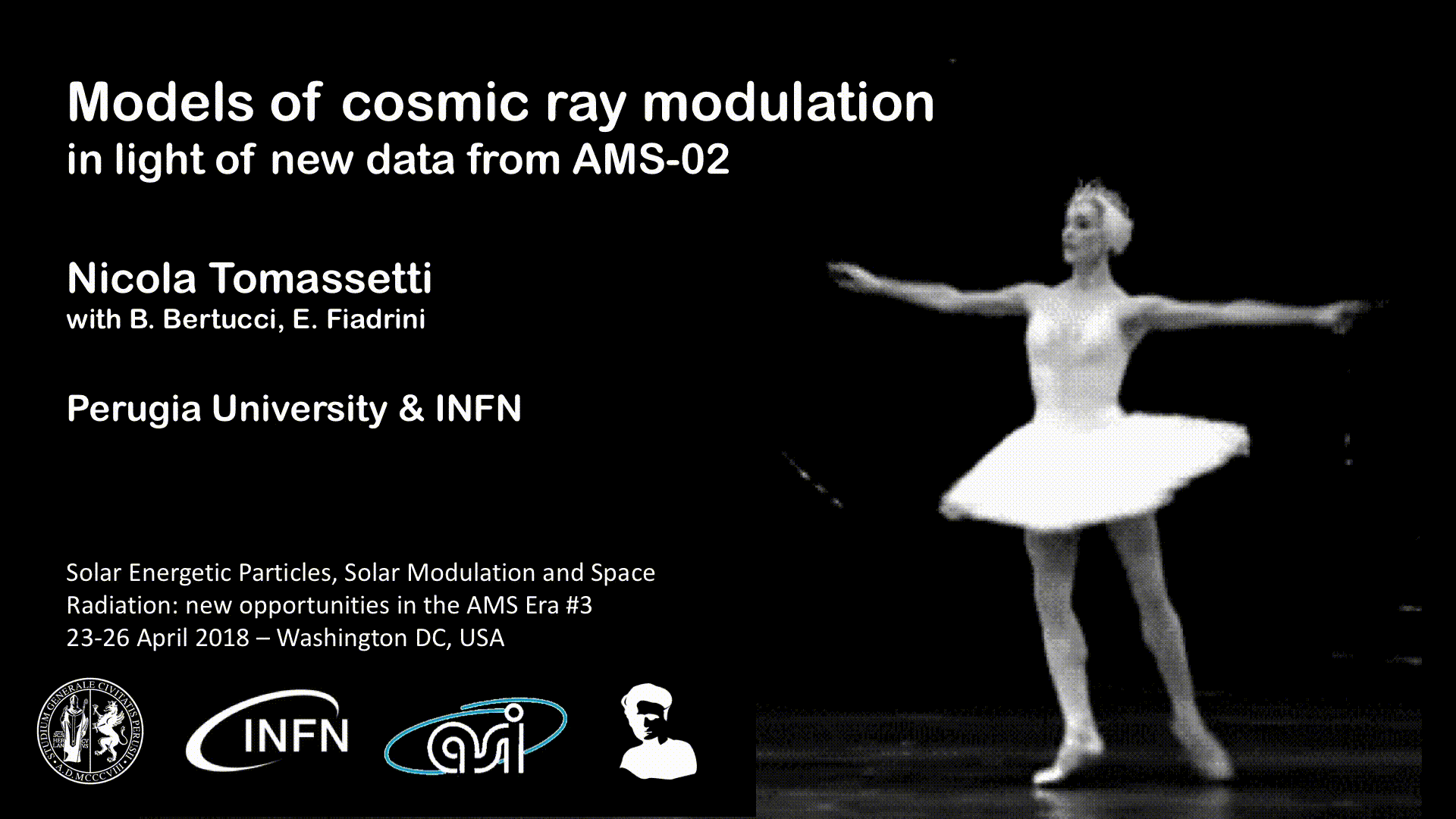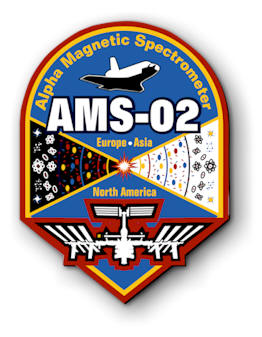The Results
The MAtISSE action had three main physics goals: (i) to extend solar modulation measurements of cosmic ray (CR) leptons and nuclei using the AMS data from the ISS; (ii) to develop numerical data-driven models of CR transport in the heliosphere; (iii) to explore a wide range of implications for the astrophysics of Galactic CRs. The actions was concluded with the achievements of its main goals. It provided relevant results with important consequences in related fields of interest that are intellectually stimulating and scientifically relevant. The main results are outlined as follows.
New precision CR measurements with AMS
Within the framework of the AMS international collaboration, MAtISSE has contributed to the data analysis activities for the time-dependent measurements of the CR fluxes. These activities led to important experimental results beyond the present state of the art. Based on the analysis of one billion particles collected by AMS, we have obtained the time-resolved measurements of the proton and helium fluxes in a wide range of energy (0.5 to 50 GeV/n) and over 72 months of observation time (May 2011 - May 2017). These results have been recently published in PRL. We found that the proton flux and the helium fluxes show nearly identical fine structures in both time and relative amplitude. The amplitudes of the flux structures decrease with increasing energy. Moreover, these amplitudes are reduced during the time period after the 2014 Solar Maximum, when both fluxes are found to increase steadily. Remarkably, a puzzling long-term behavior has been observed in the ratio p/He between proton and helium fluxes, which is shown in the figure below at 2 GV of rigidity. This behavior may reflect fundamental properties of CR diffusion in the heliospheric turbulence.
Moreover, the analysis of AMS leptonic data led to new measurements of the detailed time and energy dependence of the electron (e-) and positron (e+) fluxes, over the same analized period, in the energy range from 1 to 50 GeV. The measurement of the e+/e- ratio evolution at 2.5 GeV of energy is shown in the figure below:

It can be seen that the ratio follows a smooth transition from one value to another, reflecting the physics of the magnetic reversal. Further deailed information can be extracted from the time-dependence of the absolute fluxes at different energies. With these data, for the first time, the charge-sign dependent modulation during solar maximum has been investigated in detail by leptons alone. These results have been published in PRL.
Explanation for the p/He behaviour
The results obtained with the AMS data analysis show a remarkable long-term behavior in the ratio p/He between proton and helium fluxes. In particular, the ratio is found to be non-constant in the non relativistic regime, that is, at magnetic rigidity R = p/Z (momentum/charge ratio) below ~3 GV. Using our numerical finite-different model of CR modulation, we have interpreted this feature in terms of low-energy particle diffusion in the heliospheric magnetic turbulence. More specifically, we have shown that the p/He behavior is a remarkable signature of the low-rigidity behaviour of the diffusion of CRs in heliosphere, which depends on the particles speed β and on their mean free path λ(R), where the latter is a universal function of rigidity for all nuclei. This dependence is responsible for distinctive charge/mass dependent effects in the time-dependent modulation of low-rigidity particles. Our calculations are shown in the figure below.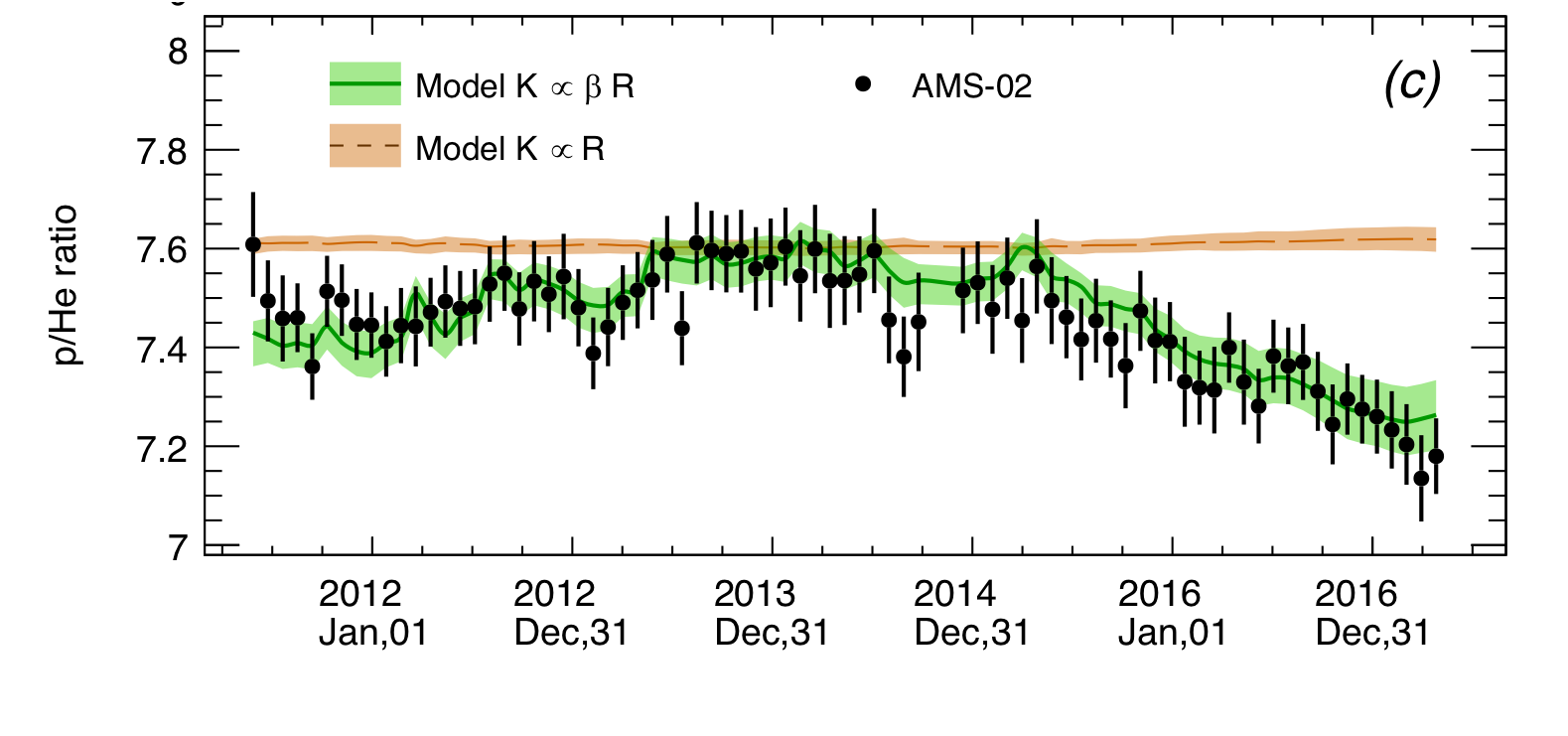
The figure illustrated the measured time profile of the p/He ratio, at rigidity R = 2 GV, in comparison with best-fit calculations for two diffusion behavior: K ~ βR (thick solid line) and K ~ R (thin dashed line). These results are being published in PRL.
Observation of a time lag in CR modulation
In a research paper made in in collaboration with the LIP- Lisbon laboratory, we have reported evidence for a eight-month time lag between Solar activity and CR flux variation. This result was obtained with our stochastic model of CR modulation in the heliophere that was directly calibrated against solar-activity data (namely, the number of sunspots and the tilt angle of the current sheet) that are provided real-time by solar observatories. Our model is built in order to account for the dynamic nature of the heliosphere by using retarded equations with a time lag parameter ΔT. Making use of thousands data on the CR proton flux collected by space-borne experiments PAMELA, EPHIN/SOHO and AMS, a lag ΔT of about eight months was obtained. The time evolution of the proton flux at energy 1 GeV is shown in the figure below, for the time period between 2000 and 2018.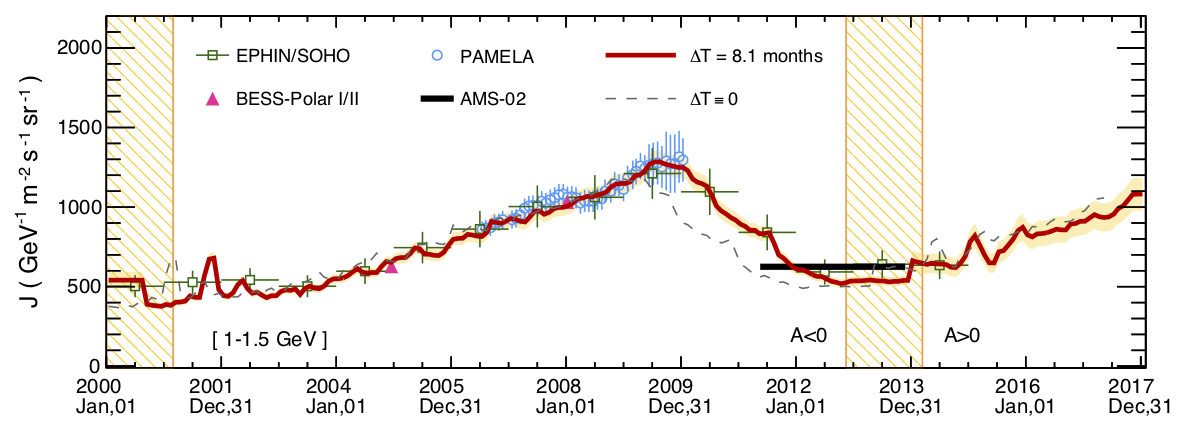
In the figure, our calculations are shown with and without the inclusion of a time lag, along with the data from PAMELA, EPHIN/SOHO, BESS, and AMS. This result demonstrates that CRs bring information on the timescale of the evolution of the heliosphere over the Solar Cycle. Moreover, this study addresses a prerequisite for modeling space weather effects, which is an increasing concern for space missions and air travelers. Since the solar activity is monitored real-time, the existence of such a lag enables us to forecast the CR flux in the heliosphere well in advance. These results have been published in ApJ Letters.
Multichannel analysis of solar and cosmic-ray data
We have performed extensive studies aimed at understanding the relationship between the variability of the cosmic-ray flux and the changing conditions of the Sun's magnetic activity. This required the collection and analysis of large time-series of multichannel data, such as measurements of counting rates from the worldwide neutron monitor network, long-term measurements of cosmic fluxes from space experiments, and solar activity observations from ground based observatories.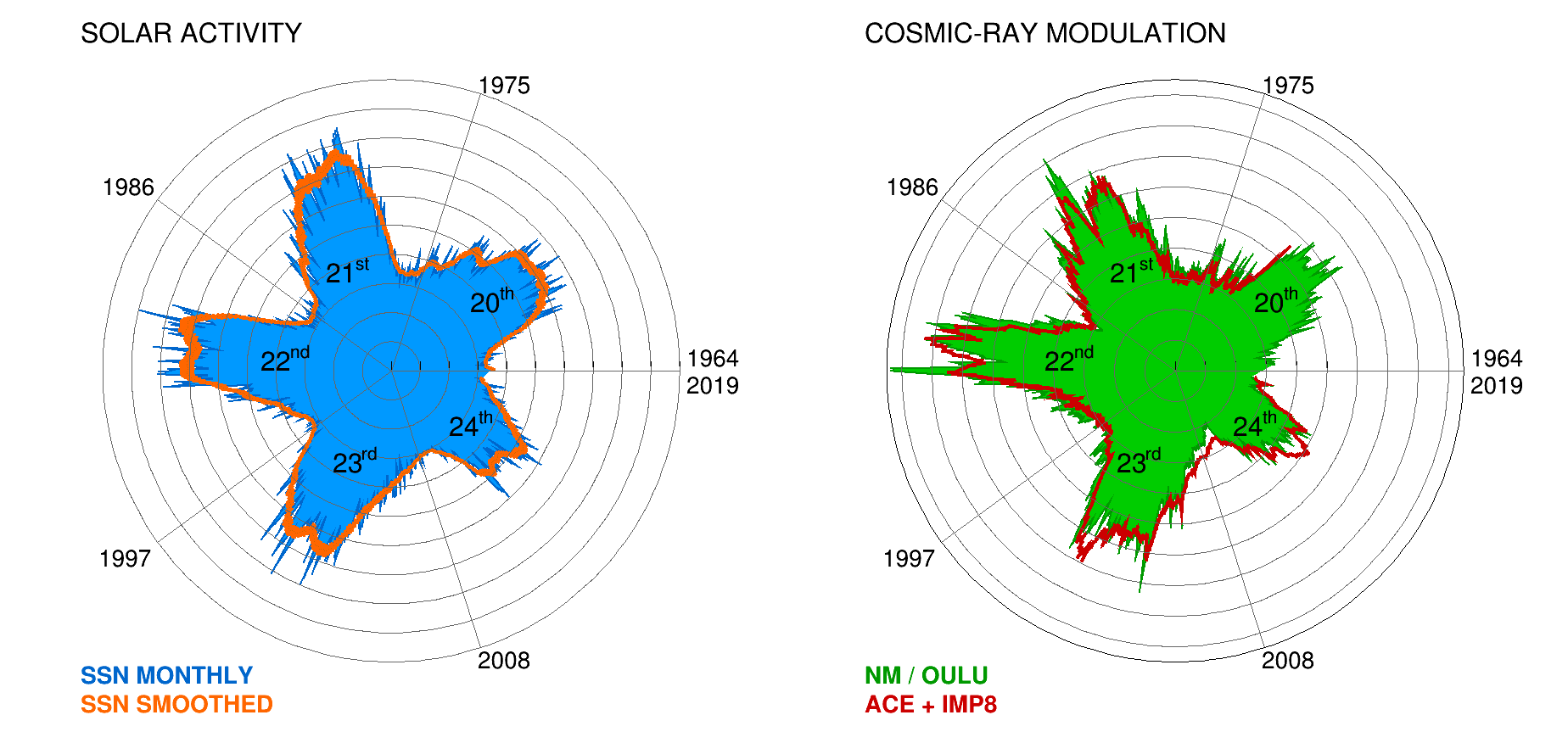
The above figure illustrates the reconstructed time evolution of the solar activity over five solar cycles (left), which is represented by the monthly (blue) and yearly smoothed (orange) sunspot numbers. The right panel shows our calculations of the solar modulation effect on the cosmic-ray flux intensities, that are driven by neutron monitor data of the OULU station (green) and by direct cosmic-ray data from the NASA spacecrafts ACE and IMP-8 (red).
Antiparticles and particles in the heliosphere
Because particles and antiparticles are bent to opposite directions by the Sun's magnetic field, antimatter brings unique information on the heliospheric plasma. Based on our stochastic model of CR modulation, from the results above, we have also made predictions for the time evolution of antimatter particles in the heliosphere. Our predictions for the antiproton/proton ratios are shown in the figure below.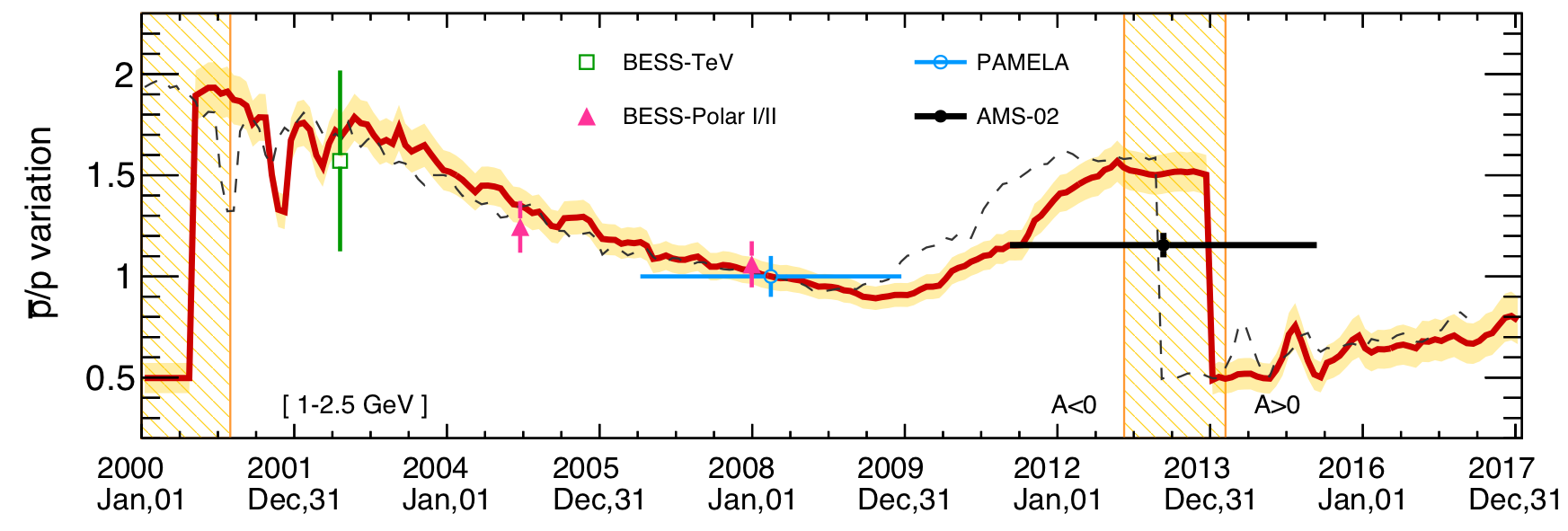
This prediction can be tested soon with further dedicated analysis of the AMS data. The release of these data will also provide crucial tests for solar modulation models and deep insights on the physics of particle transport in magnetized plasmas; From the figure it can be seen that, in the last reversal occurred in 2013, a remarkable change of antimatter/matter ratios is predicted.
Galactic nuclei, antinuclei, and origin of cosmic rays
Understanding the solar modulation effect is very important because it limits our ability in understanding the physics of CRs in the Galaxy, to identify their sources, and even to place constraints on the nature of cosmological dark matter. For these purposes, solar modulation is an important source of uncertainty in CR propagation models, as it blurs the connection between CR observations and key astrophysical parameters, therefore hiding valuable pieces of information that are potentially encoded in the data. With numerical models of CR modulation developed in the MAtISSE program, and with the improved constrained based on multichannel data, we made dedicated focus studies to estimate solar uncertainties in CR propagation and how they affect the interpretation of light (anti)nuclei data. Regarding the interpretation of the boron/carbon (B/C) ratio in CRs, our results are published in PRD. The situation is illustrated in the figure: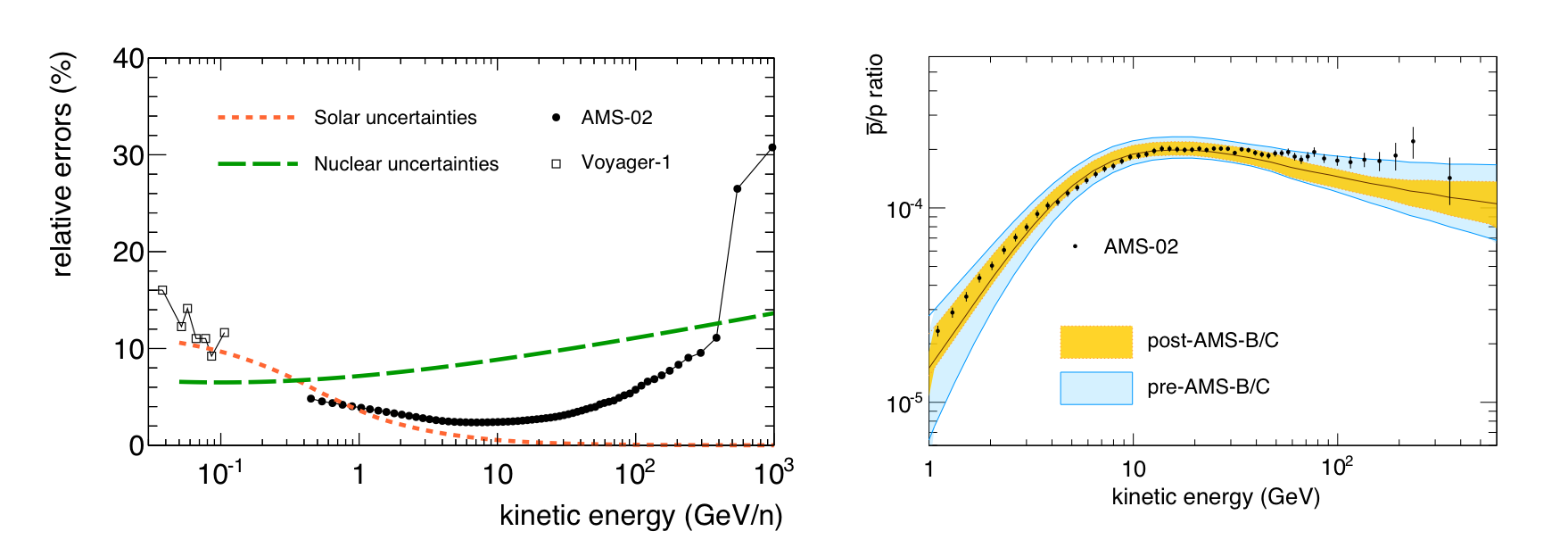
In the left panel, solar uncertainties in the B/C ratio calculations compared with the experimental errors from AMS. in the right panel, total astrophysical uncertainties in the B/C-driven model prediction of the antiproton/proton ratio, before and after the release of the AMS measurements on the B/C ratio, from our works in PRD and RNAAS. We found that a proper data-driven treatment of solar modulation can guarantee the desired level of precision, in comparison with the improved accuracy of the new B/C data from AMS. In contrast, in the interpretation of the antiproton/proton ratio, solar uncertainties are become relevant in comparison with the precision of the data and with other sources of theoretical uncertainties. The calculation framework and the fitting tools developed in this action enabled us for several studies, such as, astrophysical background calculations of antiprotons, antideuteron and antihelium fluxes as well as new Galactic models of CR acceleration, interactions and transport.
Nuclear physics processes and uncertainties
A related subject of investigation is that of cosmic-ray fragmentation reactions in the interstellar gas. Since the cosmic ray transport is mostly studied with data on secondary to primary ratios (e.g. the B/C ratio), our understanding of these processes relies on calculations of the production rate of secondary nuclei (e.g. beryllium and boron) from the disintegration or decay of heavier nuclei (such as, e.g., carbon or oxygen). Thus, the accuracy of secondary production calculations depends on the knowledge of the production and destruction cross sections employed. It is also important to stress that the fragmentation network of cosmic rays in the Galaxy may involve several steps where the disintegration or decay of intermediate particles contributes to the abundance of a final-state nuclei. The multistep nature of CR fragmentation is illustrated in the following alluvial diagram, which links the secondary Be-B isotopes (left blocks) to their purely primary progenitors (right blocks) via two stages of fragmentation calculated at 1 GeV/n of kinetic energy.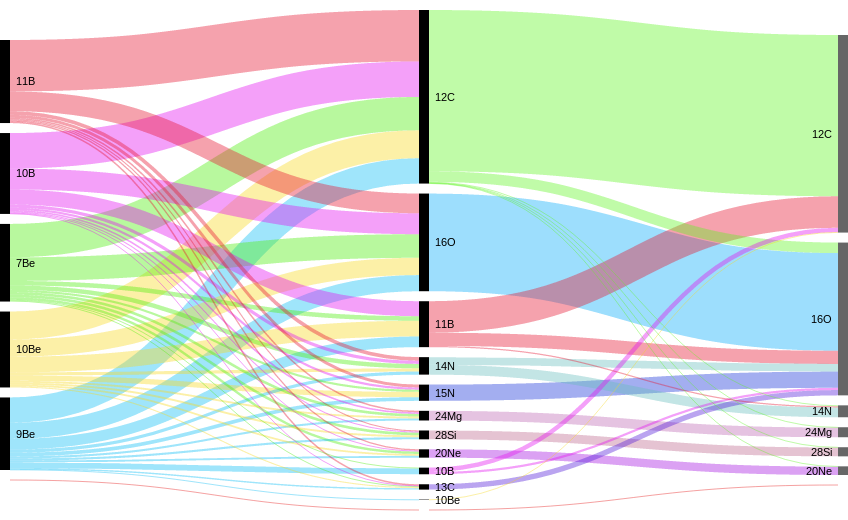
The stream fields between the blocks represent the fragmentation reaction channels (from right to left), sized accordingly to their contribution to the secondary abundances. From this graph, it can be seen that the usual view of purely primary nuclei fragmenting into secondaries is only an idealized approximation. The actual process of cosmic ray fragmentations occurs through a complex reaction network.
Space weather and space climate
Interplanetary manned missions and space settlement toward Mars and beyond will become reality within the XXI century, and combined efforts in this direction are being reviewed by all national space agencies. In this respect, an important reason to care about solar modulation is that related to human exposure to space radiation such as, in particular, chronic exposure to the CR flux in the interplanetary space. An important question addressed in this project is whether the evolution of the CR flux can be predicted in advance. Our observation of a eight-month time lag between solar activity and CR flux variations demonstrates that the level of CR radiation near-Earth and its temporal evolution can be effectively forecasted. Beyond MAtISSE, we expect that further developments of these results may transform the science of space weather by extending its scope from the near-Earth environment to the interplanetary space of the solar system. Within the project, these aspects have attracted significant attention and media coverage, which resulted in a series of interviews of newspaper articles.A short overview of the main results is given in the following slides:
